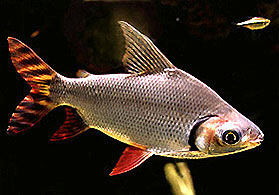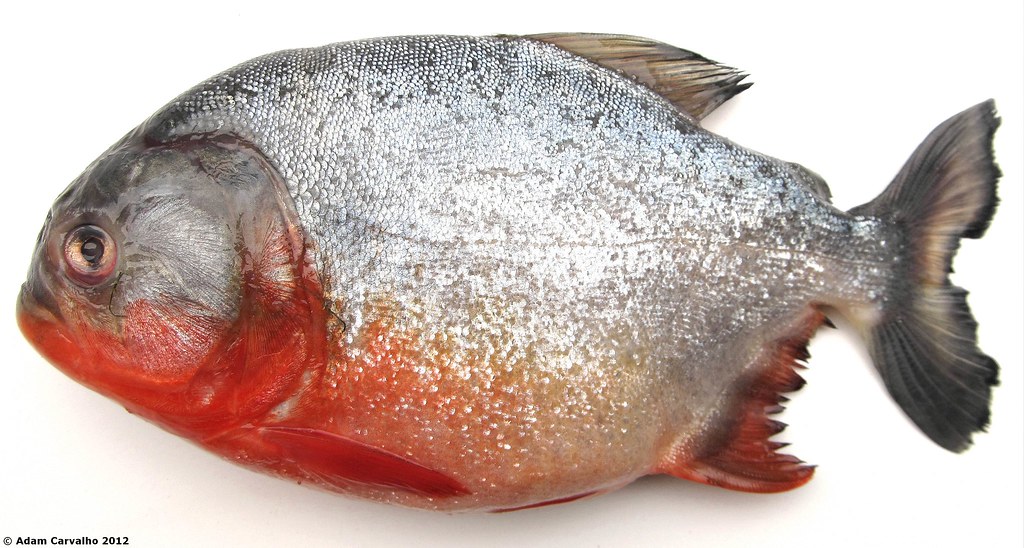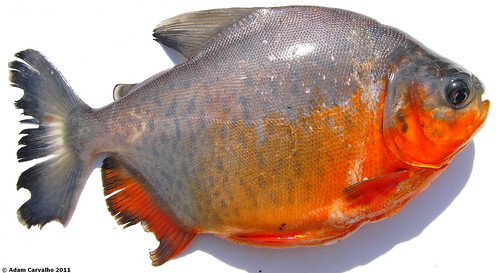Characiformes
Sternflecksalmler ( Pristella maxillary )
The Characins ( Characiformes ), also known as tetras or Salmlerfische, are an order of bony fish. It comprises about 1900 species, including the piranha and neon tetra. Some species are used as food fish, many species are due to their colors popular freshwater aquarium fish.
Dissemination
The Characins come in tropical lakes and rivers in South America, Central America and in Sub-Saharan Africa and in the Nile before ( about 210 species). This distribution pattern suggests that they have diversified during the Cretaceous period.
Features
The order of the Characins takes many forms, but most species are of barbe -like shape, but aalähnlich elongated shapes or flattened bottom dwellers are missing. The tetras America have more diverse body shapes produced as African tetras. Like all Ostariophysi are characterized in particular by the Characins the Weberian apparatus, which is built here, simple, and a number knöchriger structures between the swim bladder and the inner ear. Hallmark of most Characiformes are a small adipose fin between the dorsal fin and tail fin or possession of strong teeth. The dentition in the upper jaw usually located on the premaxilla. The maxilla is not or only weakly dentate most. Furthermore, the pterygoid and palatine may be dentate. The maxillary teeth are mehrspitzig. The Breitlingssalmlern ( Curimatidae ) the teeth are missing in old age. The upper jaw is not fully vorstülpbar, exceptions are the Keulensalmler ( Hemiodontidae ) and the Barbensalmler ( Prochilodontidae ). Pharyngeal teeth are usually available, but similar specializes only in the Engmaulsalmler ( Anostomidae ) as in the carp -like ( Cypriniformes ). Barbels missing, the number of Branchiostegalstrahlen is three to five.
The body is usually covered with scales comb or comb- scale-like scales, the head is unbeschuppt. Scales are missing only in the southernmost kind Gymnocharacinus bergii which has no dorsal fin. The pelvic fins are supported by five to twelve fin rays, the caudal fin usually has 19 principal fin rays. The anal fin is short or moderately long, with less than 45 fin rays. All fin rays are soft rays. In the males, the rays of the anal and pelvic fins may have little check mark. The first Hypuralia is separated by a gap from the vertebral body. Such a gap is absent in most other low Teleostei. The lateral line is sometimes incomplete. Characiformes are Physostomen bisected swim bladder is connected to the intestine in conjunction. It serves some Raubsalmlern ( Erythrinus & Hoplerythrinus ) as an additional Amungsorgan.
Many Characiformes are very colorful, many also silvery. The largest species is the 1.40 meter long Hydrocynus goliath from the Congo. Some species remain with a length of three inches, the smallest 13 mm.
Way of life
Many Salmlerarten are referred to in the literature as a school of fish. Most schooling fish as designated Salmlerarten show but only upon the occurrence of an alleged danger real swarm behavior. Without this external influence the swarm formation is abandoned in favor of a loose group association with a specific individual distance. This small areas can be formed that are similar to the defined and defended by a ritualized fighting behavior of cichlids temporarily. This and also the occasionally observed hierarchy presuppose that members know each other individually, which is not the behavior biological definition true schooling fish. One of the few real schooling fish under the tetras is the Rummy ( Hemigrammus bleheri ).
Tetras feed as meat, all-or herbivore. Among the predators are living in larger groups, piranhas, and elongated predatory fish, such as the spindle and Raubsalmler, the American and the African Pike Characin. The pennant Piranha ( Catoprion mento ), Gnathodolus bidens and Probolodus heterostomus are shed eaters. The Distichodontidae genera Belonephago, Eugnathichthys, Ichthyoborus & phagocytosis feed mainly on the fins of other fish. Among the herbivores include the Black Pacu, the Metynnis and the Myleus species. Only a few tetras operate parental care, the eggs are usually sold in plants. Some Characiformes can acoustically, with sounds that are generated by the offset with the help of drum muscles to vibrate the swim bladder, communicating with each other. The choir-like sounds of Prochilodus may also be carried out of the water and serve local fishermen to locate the shoals.
Outer systematics
The Characins are one of the Ostariophysi, which also includes the carp -like ( Cypriniformes ) and the catfish -like ( Siluriformes ) belong. They are the sister group of the catfish -like and form with them and the New World knife fish taxon Characiphysae. Their phylogenetic relationships are shown in the following cladogram:
Herring -like ( Clupeiformes )
Alepocephaliformes
Sand Fishy ( Gonorynchiformes )
Carps ( Cypriniformes )
Neuwelt knife fish ( Gymnotiformes )
Characiformes ( Characiformes )
Catfish ( Siluriformes )
Inside systematics
There are about 2000 species in 270 genera, 24 families and two suborders:
- Subordination Citaharinoidei, Africa, teeth zweihöckerig grown together second and third Postcleithra ( bones in the shoulder girdle ), autogenous neural arches of the fourth vertebra, ctenoid scales ( cycloid scales at Citharinus ), a relatively large belly fin rays.
- Family Geradsalmler ( Citharinidae )
- Family Distichodontidae
- Family splendor and Bodensalmler ( Crenuchidae ) Subfamily Prachtsalmler ( Crenuchinae )
- Subfamily Bodensalmler ( Characidiinae )
- Family Engmaulsalmler ( Anostomidae )
- Family headstander ( Chilodontidae )
- Family Breitlingssalmler ( Curimatidae )
- Family Barbensalmler ( Prochilodontidae )
- Subfamily Acestrorhynchinae
- Subfamily Roestinae
- Subfamily Heterocharacinae
- Subfamily Iguanodectinae
- Bryconops clade
- Subfamily Bryconinae
- Subfamily Salmi Ninae
- Subfamily Triportheinae
- Subfamily Agoniatinae
- Subfamily Clupeacharacinae
The probable kinship cladogram shows the following:
True tetras ( Characidae )
Triportheidae ( Triportheinae, Agoniatinae, Clupeacharacinae )
Bryconidae ( Bryconinae, Salmi Ninae )
Hatchetfishes ( Gasteropelecidae )
Iguanodectidae ( Iguanodectinae, Bryconops clade )
Acestrorhynchidae ( Acestrorhynchinae, Roestinae, Heterocharacinae )
Chalceidae
Schlanksalmler ( Lebiasinidae )
American Pike Characin ( Ctenoluciidae )
Breitlingssalmler ( Curimatidae )
Headstander ( Chilodontidae )
Barbensalmler ( Prochilodontidae )
Engmaulsalmler ( Anostomidae )
Keulensalmler ( Hemiodontidae )
Sägesalmler ( Serrasalmidae )
Wolfssalmler ( Cynodontidae )
Raubsalmler ( Erythrinidae )
African tetras ( Alestidae )
African Pike Characin ( Hepsetidae )
Splendor and Bodensalmler ( Crenuchidae )
Geradsalmler ( Citharinidae )
Distichodontidae
Fossil record
The oldest fossil of a fish salmlerähnlichen comes from the Albian, the chronostratigraphic highest level in the Lower Cretaceous. Santanichthys from Brazil was probably lived in marine or brackish water and is probably the oldest Characiformes or the oldest Otophysier. Next fossil Characiformes are Sorbincharax from the extinct family Sorbincharacidae, Paleohoplias and Tiupampichthys from South America, Eocitharinus, possibly a representative of the African subordination Citaharinoidei and Mahengecharax, possibly the sister species of the Alestidae. The extant genus Brycon is already known from the Oligocene, Tetragonopterus and Triportheus since the Miocene.





.jpg/250px-Schmucksalmler_(1).jpg)




